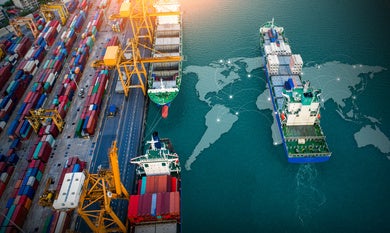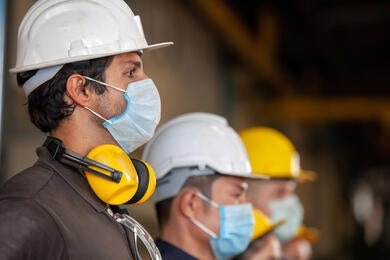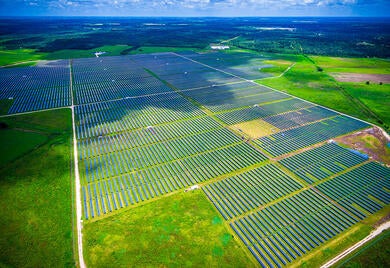
Tailored Strategies to Provide Water and Sanitation to Brazil's 'Favelas'
When a new law allowed private capital to enter the sector, water and sanitation companies established programs that enabled them to work efficiently in vulnerable communities.

How Trade Finance Boosts Access to Credit for Smaller Businesses and Food Security
Most of the world’s commerce depends on trade finance. However, the global trade finance gap surged to an estimated $2.5 trillion in 2022, widened by the pandemic and ongoing economic and geopolitical uncertainty. Narrowing this gap can have a positive impact on two pressing challenges facing the region: limited access to finance for SMEs and mounting food insecurity.

A Six-Step Roadmap to Enhance Private Sector Resilience to Health Risks
An IDB Invest poll shows nearly 60% of projects have temporarily ceased work or faced major project delays because of COVID-19. Early lessons coupled with existing best practices in public health and safety principles provide a six-step action road map to build resilience against such risks.

Three ways banks can attract millennials
71% of the millennials in the United States would rather go to the dentist than listen to what banks are saying, according to the Millennial Disruption Index, while 35% of the banks in Latin America feel they are not meeting the needs of this generation, and 71% admit they are unable to rapidly adapt to technological advances, according to a study done by the GMix program of Stanford University and Technisys. However, in upcoming years this age group will be the main source of consumers and labor. Millennials represent close to 30% of the population in Latin America and the Caribbean. For more than half of them, only innovative companies will be successful. In effect, four out of every ten believe that the private sector is the true driver of innovation, according to a survey conducted by Deloitte. For this reason, banks in the region are looking for new formulas to attract them: 1. Chile: Collaborative spaces The millennials are the “BRICs” of the age groups: due to their size, they can disrupt the economy, particularly the banking industry, according to Scratch. In Chile, banks are betting on collaborative spaces to approach this generation. Thus, was born Work/Café, a space open to the general public for working, holding meetings, and using free Wi-Fi and that already has six locations in the country. The Santander Group’s wager includes a cafeteria with discounts for clients, executives specializing in financial advice, and ATMs for cashing checks, making deposits, and transferring funds. Another characteristic sought by millennials is flexibility. Thus, these branches add four hours to traditional banking hours in Chile, remaining open for 18 hours, Monday through Thursday. Work/Café also gives talks in order to keep capturing clients constantly. [clickToTweet tweet="35% of the banks in #Latam feel they are not meeting the needs of the millennials" quote="35% of the banks in Latin America feel they are not meeting the needs of the millennials" theme="style1"] 2. Brazil: 100% virtual In Latin America and the Caribbean, 55% of the population buys products via the Internet and 90% of millennials are digital banking clients. For this reason, a Brazilian bank made the decision to be the first 100% digital bank. Banco Original developed a website, applications for mobile telephones, tablets, and even Smart TVs to reach its public on line and close its branches. To avoid in-person visits, this Brazilian bank developed a site with services for personal, commercial, and agribusiness banking. In addition, it developed Bot Original, a service enabling interactions via Messenger and even on Facebook, with a robotic system of instantaneous responses for clients. 3. Mexico: On-line support for SMEs One of the region’s largest financing gaps is experienced by small and medium enterprises (SMEs); this gap is estimated at between $210 billion and $250 billion. However, for more than half of the region’s millennials, a venture is one of the most important achievements. Thus, the banking system is seeking ways to facilitate access to financing for SMEs given that applications for financing for companies of this type still require in-person visits in many countries. Bankaool, Mexico’s first 100% on-line bank, developed financing tools for SMEs. Clients can apply for and receive financing for their businesses in a more streamlined and expeditious way. This has also allowed the bank to carve out a niche within the financial industry based on its work generating inclusive businesses. Innovative wagers continue to flourish in the region and in the rest of the world, from applications for different financial operations and the use of biometric profiles, to the development of products for women’s banking. They all seek a positive effect on returns, efficiency, and the consumer’s experience. It is thus essential to continue looking for strategies that make attracting millennials possible since, as John D. Wright once said, “Business is like riding a bicycle. Either you keep moving or you fall down.” Now we need to see what the banking sector’s next move will be in the region. Subscribe to receive more content like this! [mc4wp_form]

Four countries leading in solar in Latin America and the Caribbean
Nearly half of the global electric power capacity could come from solar energy by 2025, according to McKinsey & Company. Multiple Latin American and Caribbean countries, benefitting from exceptional resources and evolved regulatory frameworks, have seen rapid growth in solar energy in the last few years. Utility scale projects are now considered commercially viable and receive private financing, while the application of distributed solar is growing quickly. However, falling solar prices are squeezing the industry, and macroeconomic uncertainty will continue to test its strength. Meanwhile, developers are now consolidating to gain market share and achieve profitability.

How cattle ranchers can profit from planting trees
In agriculture it’s not often that you find a relatively simple way to increase production by up to 20%. Planting trees turns out to be one such way for cattle farmers. Cows like shade and grow much faster if they graze on pastures dotted with trees. Studies show that combining livestock herding and forestry on the same stretch of land can lead to an 8% to 20% increase in dairy and meat production in the Southern Cone region.